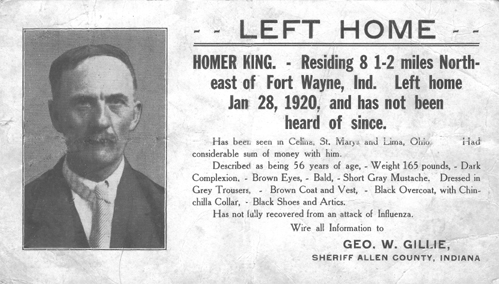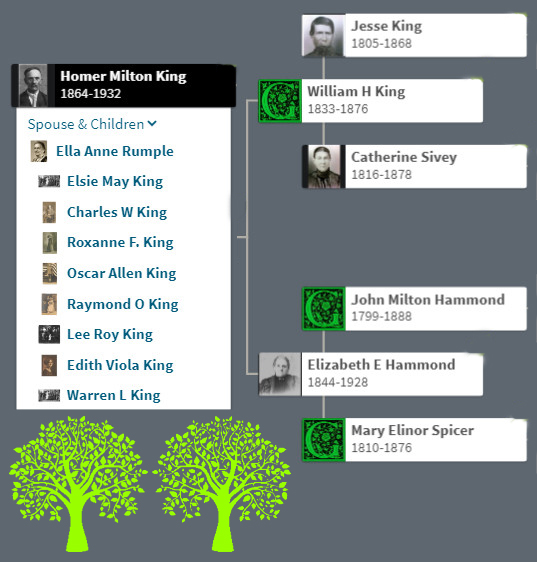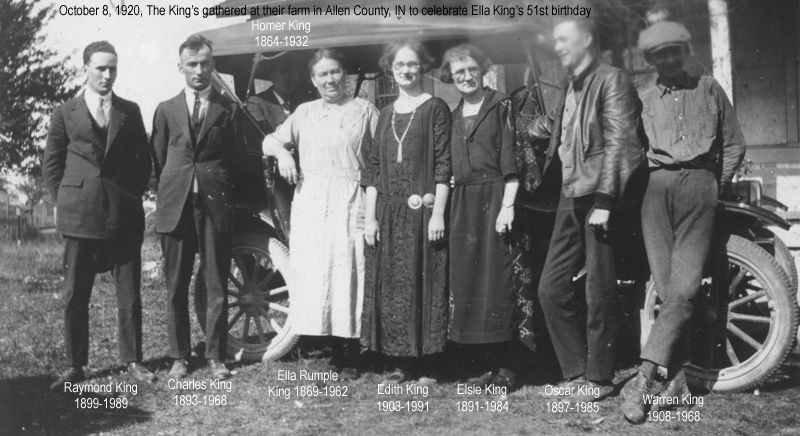
Homer King: Missing
Family lore holds that my great-grandfather, Homer King 1864 – 1932, suddenly, and inexplicably, sold the family farm in 1920 just as the crop was ready for harvest. The story goes he then left home with the money from the sale in his pocket. The story ends with him returning home many months later claiming to have had amnesia and with no idea of what became of the money. In truth, it surprises me this story survives 100 years later, especially since none of the principal parties involved are still living. I have searched for records to support this bit of family lore and have gathered here what I know to date.
Background Info
Homer was born into a farming family in Black Creek Township, Mercer County, Ohio in 1864. His parents were Elizabeth Hammond and William King. Homer experienced a good deal of loss as a child when two younger siblings died in 1872 and then his father died in 1876. After the loss of his father, his widowed mother was forced to sell their farm and then soon re-marry. Homer worked as farm labor, eventually he leased a farm, and then later owned a farm. Homer married my great-grandmother, Ella Rumple 1869 – 1962, in 1890 and they went on to have eight children. [1]
My Analysis of the Records
The best record is an item in my mother’s personal archive. It is a handbill from the time when Homer went missing. The handbill supplies the date Homer went missing as January 28, 1920 and that he had a “considerable” sum of money. Overall, this item supports the basic story. The handbill also mentions that Homer had not fully recovered from influenza, and I wonder what impact that may have had on his actions.
Local Directory
The 1919 Polk Directory for Allen County, Indiana has Homer King living in St. Joseph Township, which is northeast of Fort Wayne. [2] The directory lists him as “p”, which is their shorthand for “personal”, and with $720 of personal property. The directory uses “f” for “farmer” which leads me to wonder if Homer did NOT own a farm in 1919. The 1918 directory also lists Homer as “personal” and I do not have access to a 1920 directory. [3] On the other hand, the information in the Polk Directory may have been collected late in the prior year. Maybe Homer did not own a farm in late 1918 but did in 1919. Another possibility is Homer was a tenant farmer and he sold his lease and crop and NOT a farm.
1920 Census
The 1920 U.S. Census for Allen County was enumerated on January 7 and 8, 1920. Homer is listed as a “Renter” and a “Farmer” working on his “Own Account” in St. Joseph Township. Ella, their sons Raymond and Warren, and daughter Edith are listed as part of Homer’s household. Twenty years-old Raymond is given as “farm laborer” for “home farm”. [4] The rest of the family have no employment listed. Did Homer sell the farm before the census? Nothing I have found leads me to think Homer owned a farm at any time in 1919. Given that, this record does support that Homer was a tenant farmer. When did it happen if it was a lease that Homer sold and NOT a farm? If it was the lease on the farm he was renting at the time of the census, then the crop was something harvested in the winter in northern Indiana. What would that be? The King’s grew livestock feed grains, like alfalfa harvested in August.
Photographic Record
While Homer is missing in 1920, two of his sons get married. Oscar, who was living in Michigan, quietly married in March. Raymond had a more formal affair in June when he married in Fort Wayne to Minnie Henschen. [5, 6] Among my mother’s archives is a photo of the King family labeled “My 51st birthday.” Ella King turned 51 on October 8, 1920. My mother can identify everyone in the photo, including her grandfather Homer King, who is sitting in the car in the photograph. This means Homer returned home sometime before this date and was missing for no more than about 8 months. Nonetheless, where was he and what became of the money he had with him? So far I have discovered no records to conclusively account for his whereabouts.
Family Lore
I will never know the true details behind this bit of family lore, but I do have some theories. I don’t think Homer owned a farm in 1919 or January 1920. It’s more likely he sold, or assigned, his lease to someone. Presumably he would have gotten a good price if in fact there was a crop to harvest. But, that would mean he sold the lease several months prior to his disappearance. Perhaps the story has been altered, and it was a sown crop that was sold, that makes more sense with his departure in January. Certainly he would have sown in the winter wheat crop in September 1919 for harvest in the summer of 1920.
Conclusion
One of my aunt’s recalls being told that Homer would rent run-down farms and fix them up, only to have the landlords raise the rent due to the improvements! She recalls being told Homer would simply walk away rather than be forced to pay the higher rent on the property he had improved. Finally, I imagine stress and anxiety was probably just as much an issue for an early-20th century farmer as it is for a modern day adult. Consider the thought of being 56 years-old, and solely responsible for a farm at a time when it was mostly manual labor. At any rate, he may have grown weary of fixing up someone else’s property to make his living as a farmer.
The handbill mentions Homer was seen in the vicinity of Celina, St. Mary’s and Lima, Ohio. Homer’s 75 years-old, widowed mother was living in Celina at the time, and his 40 years-old half-brother lived in Lima. Maybe he spent several months with his mother and his half-brother. The money he had with him would have sustained him at least that long if he stayed with family. All and all, there’s nothing like a mother’s care when you are not feeling well or are in need of sympathy.
EPILOGUE
By 1923 Homer and Ella were on their own. All their children had moved away, all but one (Raymond) were working in factories. This is when Homer and Ella transitioned from farming to running a boarding house. However, in 1932 the King’s were renting a small farm near the town of Tyner in Marshall County, Indiana and doing a little farming. Homer was helping a neighbor with unloading a hay wagon when he fell and struck his head. The injury being the cause of his death.
Other Posts
about the King Family
SOURCES:
- Profile for Homer King, ‘Osborn‘ family tree, Ancestry.com
- Entry for Homer King, City directory, Allen County, Indiana, 1919; Pub: RL Polk of Indianapolis; p1495
- Entry for Homer King, City directory, Allen County, Indiana, 1918; Pub: RL Polk of Indianapolis; p1454
- Entry for Homer King, U.S. Federal Census, Year: 1920; Census Place: Saint Joseph, Allen, Indiana; Roll: T625_422; Page: 2B; Enumeration District: 23
- Entry for Oscar King, Marriage record, Ancestry.com. Michigan, Marriage Records, 1867-1952 [database on-line]. Provo, UT, Ancestry.com Operations, Inc., 2015. Original data: Michigan, Marriage Records, 1867–1952. Michigan Department of Community Health, Division for Vital Records and Health Statistics. Record# 202
- Entry for Raymond King, Marriage record, Allen County, Indiana; Index to Marriage Record 1824 – 1920 Inclusive Vol, W. P. A. Original Record Located: County Clerk’s O; Book: 50; Page: 547, FHL film: 2130029
- Entry for Ella King, City directory, Allen County, Indiana, 1921; Pub: RL Polk of Indianapolis; p7
- Homer Milton King, Online memorial, FindAGrave.com, https://www.findagrave.com/memorial/17892981







0 Comments